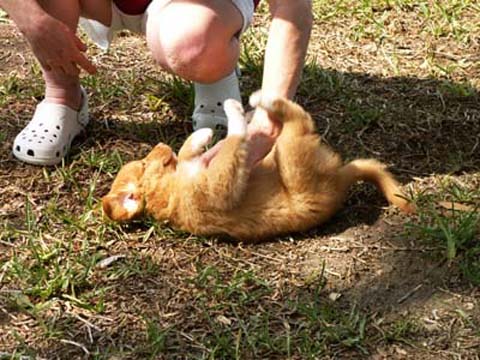















Origin and Purpose of the Toller The Nova Scotia Duck Tolling Retriever was developed in Nova Scotia in the early 19th Century to toll (or lure) and retrieve waterfowl. The tolling dog runs, jumps, and plays along the shoreline in full view of a flock of ducks, occasionally disappearing from sight and then quickly reappearing, aided by the hunter, who throws small sticks or a ball for the dog. The dog's playful actions arouse the curiosity of the ducks swimming offshore and they are lured within gunshot range. The Toller is subsequently sent out to retrieve the dead or wounded birds.
You can click on any photo to enlarge
General Appearance
The Toller is a medium-sized, powerful, compact, balanced, well-muscled dog. He should show a high degree of agility, alertness, and determination. Many Tollers have a slightly sad expression until they go to work - then their appearance changes to intense concentration and excitement. At work, the dog has a speedy, rushing action, with the head carried out almost level with the back and heavily-feathered tail in constant motion. Ideal height (at the withers) for males over 18 months 18-21 in (ideal is 19”); females over 18 months 17-20 in (ideal is 18”). Weight should be in proportion to the height and bone of the dog.
Coat and Color
The Toller was bred to retrieve from icy waters and must have a water-repellant double coat of medium length and softness with softer dense undercoat. The coat may have a slight wave on the back, but is otherwise straight. Some winter coats may form a long loose curl at the throat. Featherings are soft at the throat, behind the ears, and at the back of the thighs, and forelegs are moderately feathered. Color is various shades of red with lighter featherings and underside of tail, and usually at least one of the following white markings - a tip of tail, feet (not extending beyond the pasterns) chest and blaze. The pigment of the nose, lips and eye rims is to be flesh-colored, blending with coat or black.
Health
Tollers are not plagued with many of the genetic problems present in other popular retriever breeds. Presently, breeders are working to keep dysplasia, eye problems and other genetic abnormalities to a minimum. In general Tollers are a robust, healthy breed.
Tollers who are part of the breeding pool should be certified by the Orthopedic Foundation for Animals (OFA) to be free of hip and elbow dysplasia at the age of two, OFA Thyroid, and OFA Cardiac. They should also be tested by OptiGen for their genetic PRA Pattern and results registered with the Club’s Eye Registry. Breeders should also make sure the parents have been checked by a veterinary ophthalmologist for signs of heritable eye diseases. This should be done every 12-18 months before they are bred and a clean bill of health produced and given to puppy buyers.
This does not guarantee that the puppies will be 100% free of the problem, but it does go a very long way in insuring that breeders are doing everything they can to keep it limited.
Temperament
The correct temperament of an adult Toller is gentleness (with children especially), intelligence and outgoing in the field. With strangers, adult Tollers generally are somewhat leery at first, especially if the owner is distant. However, when they feel the owner is outgoing and friendly with people, they too show a great deal of friendliness to people. There should be no sign of aggressiveness in a general situation with people or with other animals. Curiosity might be a better word.
People who are looking for a small version of a Golden or Lab in obedience/field or hunting work will find a major difference in the personalities of the breeds. Tollers have a "spark." Puppy selection from a litter is usually still up to the breeder. Some will allow potential owners to come and select an individual puppy. Other breeders listen and learn from the owner what they want and expect from their Toller puppy; study their pups and during the eight weeks of early life select the individual puppy for each home.
Discipline is needed (as with all dogs) - but with firmness NOT HARSHNESS. Control might be a better word than discipline. You must let your Toller know you are the leader of the pack and worthy of its respect and loyalty. Harshness only meets stubbornness. They are very intelligent and will work well with a happy, gentle hand most times.
Environment
We have Tollers living in ALL WEATHER CONDITIONS - very southern, humid atmosphere; the desert areas; heavy winter areas, all over the US and all do well. Tollers live in cities and out in the country. Tollers and owners learn to adapt!
Training
Today's Toller is a very intelligent dog. They respond to many cues of normal family life. Rarely can an owner pick up keys and not find the Toller at the back door. The click of a shell being chambered in the gun will light up the eyes and the dog will raise up almost on tip-toes.
Many Toller owners who compete in Obedience report that the dog is happiest when working. However, they also report the Toller has its own timetable for learning. They are bright, intelligent, and easy to train if you are experienced. However, they are ardent observers of life and as young dogs are easily distracted in the ring. While they learn quickly, they also bore quickly. Training sessions must be kept short and light, fun and challenging.
Training a Toller is best based on communicating your knowledge to him in whatever field you are working. There are a good number of members in each area who are happy to pass on their success AND not so successful stories in an effort to make it easier for you and your Toller.
The Nova Scotia Duck Tolling Retriever has broken free of the constraints of the hunting technique for which it's named. Today the Toller is multi-faceted. You get the ideal dog...a retriever, a hunter, a loyal watchdog, a show dog (obedience or conformation) and a wonderful loving pet all rolled into one!
PLEASE! Visit the Public Education page of the NSDTRC-USA website to find multiple brochures about Tollers, including “So You Think You Want to Get a Toller” and “Top 10 Reasons to Own or Not Own a Toller.”
 |
 |